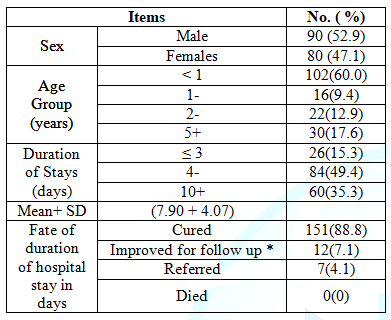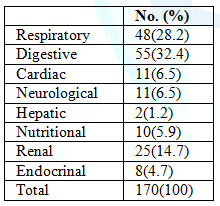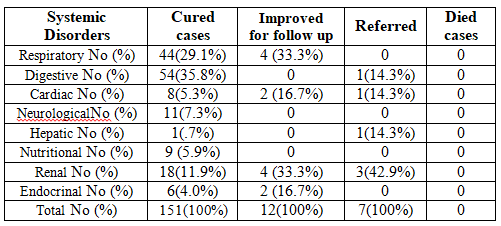Research Article :
To determine pattern of admissions and to study
the types of illness and their outcomes in relation to disease at General
Pediatric Ward at Benha Teaching Hospital (BTH). This study was a
retrospective study. The study was conducted from 1st of May 2016 until end of
December 2016. The study was done in the General Pediatric Ward at Benha
Teaching Hospital (BTH). The medical record of all admissions searching for
age, gender, address, mode of admission, referral source, duration of hospital
stay and outcome. Mean + SD of Duration of stays in days was (7.90 + 4.07). 28.2% of patients were admitted due to
respiratory system related causes, 32.4% due to digestive system related
causes, 6.5% due to cardiac system related causes, 6.5% due to neurological
system related causes ,1.2% due to hepatic system related causes, 5.9% due to
nutritional system related causes, 14.7% due to renal system related causes, 4.7%
due to endocrinal system related causes. : An understanding
of epidemiological trends in hospital admissions, including mortality pattern is
critical for health care planning and appropriate resource allocation [1]. Analysis
of Hospital admission gives us information on the burden of diseases in the
community. Knowing the important causes of childhood morbidity and mortality
enables planners to design proper priority setting and intervention planning. The
diseases which contribute most in Pediatric admissions
are respiratory tract infection and gastrointestinal problems and the major
cause of death in children less than 5 years of age are also acute respiratory infection
and diarrheal diseases
[2]. There is
variation in pattern of admissions which partly result from the referral and
admission process that is via general practitioner, other hospital or self-referral
to tertiary care hospital. The demand on inpatient services is increasing with
more children admitted to hospital [3]. There is little
information on the pattern of pediatric admissions and mortality as well as
referral mode. This paper identifies important causes of pediatric medical
admissions and outcome in relation to disease. It also identifies residency and
mode of referral to the hospital [4]. Specialist
diagnostic procedures, emergency treatment following accident and routine,
complex and life-saving
surgery are found to be causes in pediatric admissions [5]. Aim of the study: We aimed to
determine pattern of admissions and to study the types of illness and their
outcomes in relation to disease at the General Pediatric Ward at
Benha Teaching Hospital. Subjects and
Methods: This was a
retrospective study. The study was conducted from 1st of May
2016 until end of December 2016. The study was done in the General Pediatric Ward at Benha Children
Hospital. Approval
to implement the study was obtained from the Head of the Pediatric Unit and
General Manager of the hospital to access patients files. Ethical
considerations was obtained (Written consent was obtained from the parents to access their
childs files, The steps of the study, the aims, the potential benefits and
hazards, all was discussed with parents of patients). The data were coded, entered and processed on computer
using SPSS (version 18). The results were represented in tabular and
diagrammatic forms then interpreted. Mean, standard deviation, range, frequency, and percentage were use as descriptive
statistics. The following test was done: Table (1) shows that, the distribution of the
previously admitted children to BTH ward, into Sex (male/female), Age group in years
(<1 /1-/ 2- /5+), Hospital stays in days (≤ 3 /4- / 10+). Mean + SD of Duration of stays in days was (7.90 + 4.07), and fate of the admitted cases (cured/
Improved for follow up /referred/died). Table 2 shows that , 28.2% of previously admitted group was
admitted due to respiratory system affected, 32.4% due to digestive system
affected, 6.5% due to cardiac
system affected, 6.5% due to neurological system
affected, 1.2% due to hepatic system affected, 5.9% due to nutritional system
affected, 14.7% due to renal system affected, 4.7% due to endocrinal system
affected. Table
(3) shows that,relation between child systemic disorders
and their fate (Previously admitted group). Table 3: Relation between child systemic disorders and their fate in previously admitted group (No=170). The demand on inpatient services is increasing
with more patients being admitted to the hospital. Increased hospital
admissions either because of population reflect previously unmet need,
increased parental awareness and demand or inappropriate use of inpatient
resources [6]. The study presents an
overview of the care of children in BTH, providing insight into the types of conditions
for which children are hospitalized. It was seen significantly in our study that
80% of the admitted children were at or under the age of 5 years (between
infancy and early childhood
age groups) Chalmers et al. showed
that children under the age of 5 years had the highest admission rate (29.1 per
1,000 populations: 8,002 admissions) [1,2]. This study showed that, Mean + SD of duration of stays in days of the previously
admitted group was (7.90 + 4.07). This agrees
with Shahab et al., which found that Mean
+ SD of duration of stays in days was (7.6 + 6.1) [7]. In our study, it showed that short hospital stays (less than 10 days
duration) were more than 64.7 % of the admitted cases while long hospital stays
(more than 10 days duration) were less than 35.3% of the admitted cases. The
reason for reducing the length of stay was showed by Saxena et al. [8]. This study showed that, the age group
distribution is showing that 60% of the previously admitted group children are
at Infancy group (<1 year), 6.9% of them are (1-), 12.9% of them are at (2-)
and 17.6% of them are at (5+). This agrees with Stewart et al., [9] which made a
descriptive study was carried out at West Medical Unit of The Childrens Hospital, Pakistan
Institute of Medical Sciences (PIMS) Islamabad over a period of one year. All
the admissions were analyzed for age, residence, mode of admission and referral
source. Final diagnosis and outcome, grouped according to involved organ system
was analyzed. Stewart et al. found
that, there was increased frequency of admissions in younger children and
infant that is 70% and 37% respectively. Muluneh et al., [10] reported that 50% and 58% of admissions are
of children less than 2 years of age. In another study from Addis Ababa 76% of
Hospital admissions were less than or equal to 5 years of age. This study
showed that 28.2%was admitted due to respiratory system affected. This agrees with Chalmers et al., [1,2] which showed respiratory disorders were common
in children under 15 years of age, accounting for nearly a quarter of all
emergency admissions (23.0%). This agrees also with Shahab et al., [6] which found that Respiratory conditions (22.8%)
were the most common reasons for admission. Respiratory conditions were the most common reason for
non-neonatal hospitalizations among children (pediatric
illness) [11]. This
study gives an overview of the pattern of Pediatric Medical admissions,
catchment area and referral mode. The findings of this study increased the
understanding of admission trends, referral area and source. Admissions load
mainly contributed by under five children with infection and they are directly
approaching the Hospital. There is a need for the development of community based
services and short stay facility for these preventable and treatable diseases
and timely referral to hospitals. 1.
Chalmers J,
Leigh-Brown A, Tait J. Childhood Hospital Admissions &
Mortality (2009) Statistical
Publication Notice. 2.
Chalmers J, Leigh-Brown A, Tait J. Childhood
Hospital Admissions & Mortality (2010)
Statistical Publication Notice. 3.
Eck C, Pierre RB, Hambleton IR. Medical
Pediatric admission Patterns at
the University Hospital of the West Indies: Issue for future planning (2006) West Indian Med J. 4.
Haque A, Bano S. Improving outcome in Pediatric Intensive care unit in
academic hospitals in Pakistan (2009) Pak
J Med Sci. 5.
Healthcare Cost
and Utilization Project (HCUP). (2003) Agency for
Healthcare Research and Quality. 6.
Katz M, et al. Appropriateness of
Pediatric admission to a tertiary care facility in Israel (2001) IMAJ. 7.
Muluneh D,
Shimelis D, Benti D. Analysis of admission to the Pediatric
Emergency ward of Tikur Anbessa Hospital in Addis Ababa, Ethiopia (2007) Ethiop J Health Dev 21: 48-52. 8.
Saxena S, Bottle
A, Gilbert R, Sharland M. Increasing Short-Stay Unplanned Hospital
Admissions among Children in England (2009)
Time Trends Analysis 4: e7484. 9.
Shahab N, Munir S,
Bhatti N. Analysis of Pediatric Medical Admission Pattern to
a Tertiary Care Hospital (2010) Ann Pak Inst Med Sci 6: 219-222. 10. Stewart M, Werneke U, MacFaul R,
Taylor Meek J, Smith HE, et al. Medical and social factors associated
with the admission and discharge of acutely ill children (1998) Arch dis child 79: 219-224. Ebrahim HT, MD Pediatrics, Consultant Pediatrician, Benha Teaching Hospital, Qalubia Governate, Egypt, Email:
mgamsy@gmail.com Elmogy MH, Ebrahim HT, El-Sayed MR. Pattern of Admissions in the Department of Pediatrics at Benha Teaching Hospital, Egypt
(2018) Nursing and Health Care 3: 11-13 Pediatric, Admission, Pattern, OutcomePattern of Admissions in the Department of Pediatrics at Benha Teaching Hospital, Egypt
Elmogy MH, Ebrahim HT and El-Sayed MR
Abstract
Objectives: Full-Text
Introduction
Statistical Analysis
P value was considered significant
as the following: Results



Discussion
Conclusions
References
*Corresponding author
Citation
Keywords